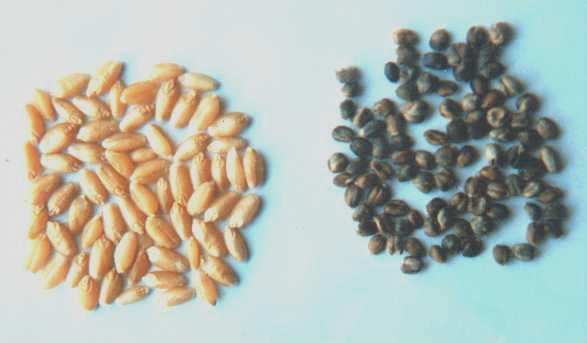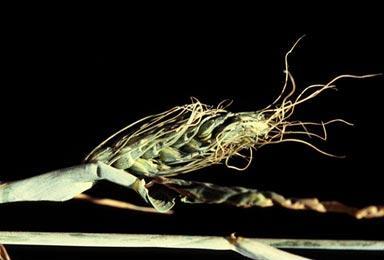Nematodes - barley
Contributors to this section: ICARDA, Syria (Siham Asaad, Abdulrahman Moukahal).
Seed Gall Nematode
Scientific name
Anguina tritici (Steinbuch, 1799) Filipjev, 1936
Importance
Seedborne.
Significance
Nematode damage is negligible in countries adopting modern mechanical and cleaning procedures to separate the nematode galls from visible wheat seeds. The use of high quality seeds has nearly eradicated this nematode from developed countries. However, the nematodes cause severe crop losses to rye (35-65%) and wheat in third world countries, where poor agricultural practices, monoculture and the use of poor quality seeds are widespread. In spite of the insignificant damage caused by the nematode in modern agricultural production systems of developed countries, their ability to export grains to the international markets is severely hampered if historical records still record the presence of this pest in grain production areas due to the quarantine measures imposed by many countries because of this pest.
Symptoms
Distorted leaves and stems are evident prior to heading. As diseased plants approach maturity, galls are formed in the florets, replacing the kernels. The galls are similar in shape to the seed they replace and are dark brown in colour. Large numbers of motile larvae are present within the galls and become active after the galls have been moistened. These nematodes can act as vectors of Corynebacteriurn tritici.

Healthy seed Seed Galls

Diseased spike
Source: www.forestryimages.org
Hosts
Emmer (Triticum monococcum), rye (Secale cereale), spelt (T. spelta) and wheat (T. aestivum). Barley (Hordeum vulgare) is a very poor host. There is no evidence that this nematode reproduces on oats (Avena sativa) and other grasses.
Geographic distribution
USA, Australia, Austria, Brazil, China, Egypt, England, Ethiopia, France, Germany, India, Italy, Hungary, the Netherlands, New Zealand, Pakistan, Romania, Sweden, Switzerland, Syria, Turkestan, Russian Federation, Serbia, Montenegro, Kosovo, Macedonia FYR, Boznia & Herzegovina, Croatia, and Slovenia.
Biology and transmission
These nematodes migrate as J2s in water films to plant leaves where they feed as ectoparasites at the tips, causing distortion of the leaves. Once the plant starts to flower the J2 penetrates the floral primordia and starts to feed on the developing seed. Once in the seed, the nematode undergoes its moults, continues to feed and eventually kills the seed to form a blackened "cockle" (Seed Gall). The adults sexually reproduce, the eggs hatch as J1 and then quickly moult into a J2 survival stage. The environmentally resistant J2 desiccates with the Seed Gall and overwinters. The nematodes in the Sseed Gall can survive for 30 years if kept in a dry location. When proper moisture and temperature conditions arise, the cryptobiotic J2 becomes active and starts the life cycle over again.
Detection/indexing method in place at ICARDA
- Not significant.
Treatment/control
- Crop rotation for one to two years to a non-host eliminates A. tritici from the soil.
- Seed can be cleaned by placing it in a 20% brine solution; galls float to the surface where they can be separated. The seed is then rinsed and dried (heat treated).
- Dry heat for sterilizing containers: 50oC for 30 minutes is effective.
- Flaming of metallic equipment - shovels, sampling tools, etc.
- Soil solarization. Consider the energy cost of heating soil.
- Mechanical separation is also effective in removing galls from seed.
Procedure followed at the CGIAR Centres in case of positive test
- Not applicable.
References and further reading
http://nematode.unl.edu/pest67.htm
http://www.doacs.state.fl.us/pi/enpp/nema/nemacirc/nem186.pdf
http://plpnemweb.ucdavis.edu/NEMAPLEX/Taxadata/G006S4.htm
http://wheatdoctor.cimmyt.org/index.php?option=com_content&task=view&id=75&Itemid=43
http://www.forestryimages.org/search/action.cfm?q=mcclure
Comments
- No comments found





Leave your comments
Post comment as a guest